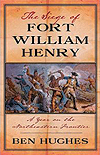
The Siege of Fort William Henry: A Year on the Northeastern Frontier, by Ben Hughes, Westholme Publishing, Yardley, Pa., 2011, $28
On March 29, 1757, amid a power struggle for North America that had been going poorly for Britain for almost three years, inexperienced soldiers of the 35th Regiment of Foot under Lt. Col. George Monro arrived at Fort William Henry in upstate New York. From there, ostensibly supported by the garrison at Fort Edward, they engaged in a war of raid and counterraid with French soldiers, Canadian colonials and their Indian allies. Then, on August 3, General Louis-Joseph de Montcalm arrived with an army to besiege the fort. Denied assistance from Fort Edward, Monro agreed six days later to Montcalm’s surrender terms, which permitted the British troops and colonial civilians to withdraw honorably to Fort Edward. As the evacuation got under way the next day, however, Montcalm’s Indians, bitter at being denied the spoils of victory to which they considered themselves entitled, brutally took matters into their own hands in a slaughter that tainted Montcalm’s honor and became one of the darkest incidents of the French and Indian War—as well as a backdrop for James Fennimore Cooper’s novel The Last of the Mohicans.
In this comprehensively researched book Ben Hughes re-creates the events leading up to and following the siege, using a wealth of firsthand accounts by participants from both warring powers, the colonials caught up in the struggle and the American Indians involved. Alternating his chapters to focus on the opposing camps, he presents an eye-opening drama of differing societies and codes of honor on a collision course toward a bloody, tragic climax.
—Jon Guttman




